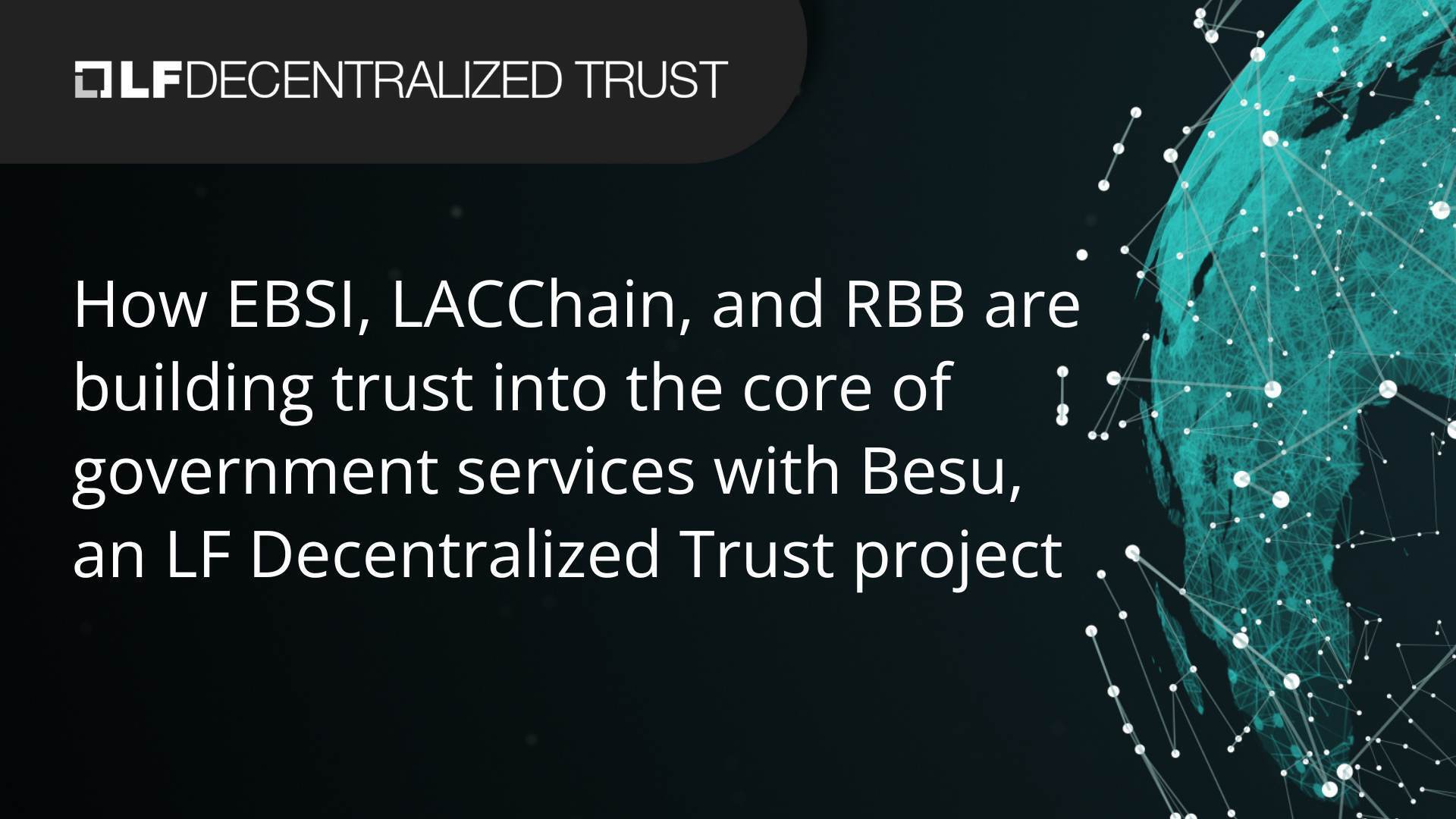How EBSI, LACChain, and RBB are building trust into the core of government services with Besu, an LF Decentralized Trust project

Read the full case study here.
Around the world, governments are deploying blockchain as a way to restore public trust and deliver citizen services more effectively. From EBSI in Europe, to LACChain in Latin America, to Rede Blockchain Brasil (RBB), a common decision stands out. They all chose Ethereum—specifically, Besu, an open-source project hosted by LF Decentralized Trust—as the backbone of their public sector blockchain networks.
Why Ethereum? The choice was not accidental and this multi-regional case study highlights some of the reasons why. Drivers include building on the proven and familiar infrastructure with Ethereum, the world’s most widely adopted smart contract platform, flexibility and long-term optionality for Public and Permission use, vendor neutrality, and compatibility with global standards.
__
Trust in governments has reached concerning lows across much of the world. According to the 2025 Edelman Trust Barometer, 60% of surveyed countries have populations that distrust them. This creates fundamental challenges for effective governance
Three regions are addressing this challenge using blockchain's inherent properties of transparency, immutability, and decentralized validation to create government services where trust isn't requested from citizens because it's engineered into the system itself:
- European Blockchain Services Infrastructure (EBSI) - The EU's cross-border verification platform
- LACChain - Latin America's regional blockchain ecosystem
- Rede Blockchain Brasil (RBB) - Brazil's national transparency initiative
These are diverse projects, with distinct needs and governance structures, that are united in their approach. They all selected Besu, a project of LF Decentralized Trust, as the core of their networks, indicating a maturing consensus about appropriate blockchain architecture for public sector uses.
Government blockchain projects face challenges rarely encountered to the same degree in the private sector. These include
- Balancing transparency with security
- Multi-stakeholder governance
- Building public trust
- Vendor neutrality and cost efficiency
- Interoperability with legacy systems
Besu, an open source, neutral platform, directly addresses these challenges. Key capabilities include its Proof of Authority (PoA) consensus protocols, on-chain permissioning, trust-inducing open code, and compatibility with permissioned and public blockchain architectures and Ethereum Virtual Machine (EVM) that allows smart contract execution.
Below are snapshots the three projects that show Besu in action in these public infrastructure projects:
Deployment snapshot - EBSI
EBSI, a joint initiative founded by the European Commission and Member States, aims to serve as a digital infrastructure across Europe's public sector in support of public policies. It tackles trust building on a continental scale, spanning 27 countries with potential expansion to associated countries with different legal systems, languages, and public administration traditions. This multi-national scope introduces governance challenges single-country initiatives don't face.
EBSI enables enhanced verification processes for documents, products, and legal entities. The network currently operates in multiple environments, from development and testing environments with four blockchain nodes each to public environments with up to 40 blockchain nodes.
At its core, EBSI implements a comprehensive Verifiable Credentials (VC) framework with trusted registries for Decentralized Identifiers (DIDs), schemas, and trusted issuers. This framework is the foundation for verifiable yet privacy-preserving digital interactions across Europe.
Deployment snapshot - LACChain
Launched in 2019 as part of an Inter-American Development Bank (IDB) Lab initiative to promote the growth of the blockchain ecosystem in the region, LACChain addressed specific trust-related challenges facing Latin American governments and institutions.
Rather than creating many small private networks, LACChain envisions purpose-specific networks for applications like CBDCs and financial use cases, all operating within a coordinated regional ecosystem that maximizes knowledge sharing and interoperability while respecting local regulatory contexts.
The public-permissioned blockchain infrastructure that underpins the LACChain ecosystem solutions is currently provided and operated by LACNet, a neutral, international nonprofit founded by LACNIC and RedCLARA in collaboration with IDB Lab within the framework of the LACChain ecosystem. LACNet ensures the continuity, governance, and sustainability of the network, maintaining an environment aligned with international standards, interoperability requirements, and local regulatory contexts.
Deployment snapshot - RBB
Brazilian Development Bank (BNDES) is a federal public company associated with Brazil's Ministry of Development, Industry, Trade and Services. It provides long-term financing for projects contributing to Brazil's economic and social development, particularly in infrastructure, industry, and environmental sustainability.
To establish trust in BNDES and across public institutions, BNDES joined Rede Blockchain Brasil (RBB) as a founding member. The initial Cohort includes the Federal Court of Accounts and a mix of public and private companies.
RBB deliberately distributes validation authority across the Brazilian governance ecosystem. This distributed governance model addresses the balancing of transparency with security that many government blockchain initiatives struggle with.
RBB is actively developing with 13 participating organizations with more to come. The team is developing sophisticated on-chain governance protocols with the goal of maintaining radical transparency while ensuring network security. They are also developing an innovative economic model they call "gasonomics," which will incentivize participation without using traditional cryptocurrency like Ether.
__
The full case study is based on interviews with the teams implementing EBSI, LACChain, and RBB. It delves into both the shared and distinct governance and technical challenges they face and how each network is addressing them. Highlights included details on the structure, stakeholders, and services for the different networks as well as a preview of future plans for each of them.
Read the full case study here.
